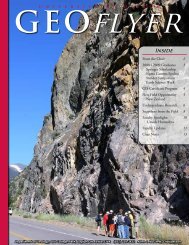Stander Symposium abstract book - University of Dayton
Stander Symposium abstract book - University of Dayton
Stander Symposium abstract book - University of Dayton
Create successful ePaper yourself
Turn your PDF publications into a flip-book with our unique Google optimized e-Paper software.
9:00 AM to 10:30 AM<br />
with metal ions, thus stabilizing the metal surface and inhibiting corrosion. Also, when enzymatically treated, L-dopa can participate in crosslinking<br />
reactions, which has been shown to lead to a thicker and more durable protein layer. In this study, cyclic potentiodynamic polarization was<br />
used to characterize the performance <strong>of</strong> the free amino acid form <strong>of</strong> L-dopa as a corrosion inhibitor. Mass loss and total charge passed were used<br />
to assess the extent <strong>of</strong> the corrosion reaction, and in addition, electrochemical impedance spectroscopy (EIS) data was also collected. The results<br />
indicated that L-dopa is ineffective as a corrosion inhibitor when not included as part <strong>of</strong> a larger polymer, most likely due to insufficient adhesion<br />
to the substrate. Preliminary exposure chamber tests were also done with an unpurified mixture <strong>of</strong> proteins from Mytilus edulis. The results<br />
indicate that the proteins are inhibiting corrosion effectively for a short amount <strong>of</strong> time before failing. To increase the effectiveness <strong>of</strong> the protein,<br />
different incubation conditions will be investigated in the future.<br />
Effects <strong>of</strong> Pipe Orientation on Multi-phase Flow Patterns<br />
Presenter(s): Heather N Nathaniel<br />
Advisor(s): Robert J Wilkens<br />
Chemical and Materials Engineering - Honors Thesis<br />
Advances in avionics and weaponry are leading to higher thermal loads for next generation military aircraft beyond what traditional PAO coolant<br />
loops can handle. One proposed solution is to use a phase change fluid to capture the additional heat. Due to fluctuating orientation and heat load<br />
transient modeling is critical. As a first step, the focus <strong>of</strong> this work is to demonstrate the effects <strong>of</strong> orientation on flow patterns observed visually.<br />
Electricity Generation using Sulfolobus solfataricus in a High-Temperature Microbial Fuel<br />
Cell<br />
Presenter(s): Henry L Aldridge<br />
Advisor(s): Donald A Comfort<br />
Chemical and Materials Engineering - Honors Thesis<br />
Microbial fuel cells (MFCs) are a developing technology that breaks down organic materials in liquids while generating electricity. They come in<br />
several forms and applications, including: micro-sized for medical implants, sediment for remote sensing and communications, and large-scale for<br />
industrial or environmental remediation. Few studies have looked at MFCs operating over 45ºC. Use <strong>of</strong> extremophiles as the fuel cell culture allows<br />
for high-temperature applications including industry, deserts, and alien space environments. This project includes the construction and operation<br />
<strong>of</strong> a membrane-less single chamber microbial fuel cell (ML-SCMFC), using the hyperthermophilic archaeon Sulfolobus solfataricus at about 80°C.<br />
The volcanic spring native S. solfataricus was used within a MFC to demonstrate feasibility <strong>of</strong> an extremely high temperature MFC and characterize<br />
the electrical power parameters from this device. A maximum power density <strong>of</strong> 25.26 mWm-3 was obtained using a carbon cloth anode and cellobiose<br />
as the substrate. Maximum sustained current densities ranging from 5.63 and 39.9 mAm-2 persisted for 15-30 hour durations. Continued<br />
modifications can potentially improve observed values, including new substrates, inclusion <strong>of</strong> separators and new anode materials.<br />
Suspension <strong>of</strong> Solid Mixtures by Mechanical Agitation<br />
Presenter(s): Tianxin Bao<br />
Advisor(s): Eric E Janz, Kevin J Myers<br />
Chemical and Materials Engineering - Graduate Research<br />
Agitation is a critical aspect <strong>of</strong> many processes, such as food production, mineral processing, and water treatment, with liquid-solid agitators<br />
representing a significant portion <strong>of</strong> all agitation installations. This research is concerned with solids suspension in a liquid-solid stirred tank at<br />
one particular agitation level just-suspended condition in which no solids rest on the tank base for longer than one to two seconds. The novelty<br />
<strong>of</strong> this work is that though there have been many studies on the just-suspended speed <strong>of</strong> uniform solid (solid particles with same shape, size,<br />
and density), there has been very little work in the industrially important area <strong>of</strong> mixtures <strong>of</strong> solids with different physical properties. The goal<br />
<strong>of</strong> this work is to investigate whether sum <strong>of</strong> the individual solids suspension powers approach can provide a reasonable estimate <strong>of</strong> mixture<br />
just-suspended speed <strong>of</strong> solids with different physical characteristics. All tested mixtures <strong>of</strong> solids with different properties (particle size, shape,<br />
and specific gravity) are categorized into three different groups based on the specific gravities <strong>of</strong> individual solids in each system: systems where<br />
the specific gravities <strong>of</strong> both solids are below 1.5 grams per cubic centimeter (i.e. low-density system), both solid densities are above 2.4 grams<br />
per cubic centimeter (i.e. high-density system), and solids <strong>of</strong> mixed densities - that is, a solid with low density plus a solid with high density. It is<br />
64

















